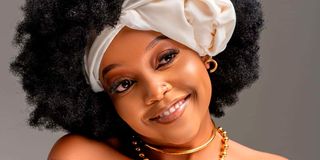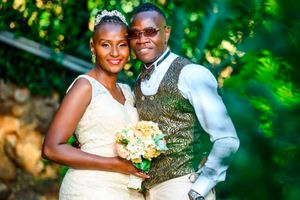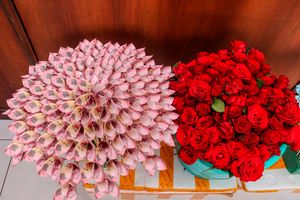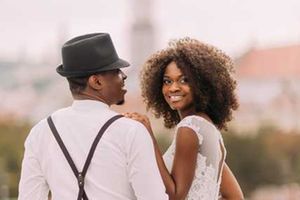
Model and designer Josephine Mueni is the wife of renowned fashion designer Austin Bolo of Bolo Bespoke.
Josephine Mueni, the wife of renowned fashion designer Austin Bolo of Bolo Bespoke, has quickly become a household name in the world of fashion and flair. With her keen eye for style and vibrant personality, Mueni captivated many with her show-stopping wedding that became the talk of the town — a glamorous affair graced by the crème de la crème of the fashion and entertainment industry. In this interview, Mueni opens up about her childhood and traces the roots of her lifelong passion for fashion.
Tell us about your early life and education…
I was born on August 31, 1994 in Nairobi. In 1999, my family moved to Mtito Andei, where I spent most of my childhood. I attended ABC Academy Manza in Machakos and later joined Machakos Girls High School. After scoring a B+ in KCSE, I was admitted to Kenyatta University to study clinical medicine.
However, I realised that the course was too theoretical for me, and I preferred more practical subjects. So, I transferred to Mount Kenya University to pursue business information technology and management, which allowed me to work during the day and attend evening classes.
I completed my studies in 2015 but chose not to attend the graduation ceremony at the time.
What influenced your decision to switch from clinical medicine to business IT?
I have always been a practical and creative person. In high school, I enjoyed subjects like geography and computer studies more than history and business studies.
Clinical medicine was heavily theoretical, which didn't align with my strengths. I wanted a course that resonated with my personality and allowed me to express my creativity.
How did your family react to your decision?
My parents were very supportive, especially my dad. We have a close relationship, and he understood my reasons for the change. He was okay with me transferring credits and pursuing a course that suited me.
After completing your studies, what career path did you take?
Initially, I aspired to work in the media industry. I applied to several media houses, hoping to become a journalist, but it didn't work out. Eventually, I ventured into sales and promotions in Nairobi. I introduced products like Fresh chewing gum to the market. I used to move from vendor to vendor to sell them. I also bought shoes from Dandora and sold them in different neighbourhoods.
How did you transition into the fashion industry?
I have always loved fashion, even back in high school. My classmates can tell you. I remember even the book I used to read then, I think it was called How to Dress for You or something like that. I would draw dresses and skirts in it all the time.
I had a this friend named Vivian in our school, and I would always ask her to draw Barbie dresses for me. I couldn’t draw myself, but I always had a vision. I have loved fashion since I was a little girl. Like, from primary school. I was always different. Even when it came to Christmas, I had a very specific taste in clothes.
My mum would never buy my clothes without me. She would say, “Come, you have to pick your dress yourself. I can’t choose for you.” Because I was very particular about what I liked. But back then, I didn’t think of it as something I could do as a business. It was about my style and self-expression.
Yet here you are, and fashion has become your world…
Yes! Look at where we are now. Funny enough, it was my husband who saw it in me. He told me, “Babe, you have great taste.” And I was like, “Okay, so what are you thinking?” When our company, Bolo Bespoke, first started, it was all about men. But as the brand grew, I advised my husband to add a women’s section. That’s how it all started. I championed the introduction of a female section in Bolo Bespoke, bringing in gowns and other feminine designs.
Did you undergo any formal training in fashion design?
Not really, but I took online classes on colour coordination and decoration. These courses helped me understand how to combine colours effectively, which is crucial in fashion design. I believe that creativity, combined with continuous learning, has been key to my growth in the industry.
Who was the first celebrity you dressed, and how did that opportunity come about?
Our first celebrity client was Sauti Sol, styled by Brian Babu. We dressed them for their Extravaganza music video. We provided all the outfits, including the iconic Kaunda suits. That collaboration introduced our designs to a broader audience, and they have been our clients ever since. They are honestly the kind of clients every designer dreams of.
They pay in cash, don’t bargain, and show up for fittings. If you ask for adjustments, they do it. They never complicate the process. The relationship is smooth, respectful, and just perfect in every way. I have to say that! And yes, they supported our growth. Bien, especially, was always generous with tags on social media.
Even though we were still a small fashion brand then, that kind of visibility meant a lot. Many celebrities did not believe in our work when we approached them, but now they come.
How do you go about designing outfits for clients?
I focus on understanding the client's personality. Before discussing the outfit, I engage in conversations to learn about their character, preferences, and the event they are attending. This approach ensures that the design aligns with who they are and makes them feel confident.
Do you ever get difficult clients, and how do you handle them?
Yes, but I have mastered the art of client management. You know, outside of fashion, I am also a customer somewhere. So when someone is being a problematic client, I try not to judge too quickly.
Think about it, sometimes you go to a spa or salon and even after they do exactly what you asked, you still leave wondering, “Why did they do that?” We have all been that difficult client in a field we don’t fully understand.
I always remember that and put myself in their shoes. That is my secret – empathy. Understanding people and handling situations the way I would want to be treated if the roles were reversed. Business has its bad days, that’s normal. But how you handle your clients, especially during unpleasant moments, is what makes all the difference.
Talk to us about your wedding…how was the planning process?
My wedding was quite the journey. I started planning it a whole year in advance. The original date was September 2023, but my husband felt things had not reached the level we envisioned, so he decided to postpone it.
Luckily, we had not sent out invites yet, we were still figuring things out, so we pushed it to September 2024.
We began actual planning and payments as early as January. That early start is what allowed us to pull off such a grand wedding.
Everything was carefully thought out and spread across the months, which really helped financially and logistically.
Tell us about your wedding dress, it looked spectacular…
Funny enough, I was proposed to in Dubai as a surprise, which I didn’t know at first, but it worked out perfectly because luxury fabrics and lace are easily accessible there. Right after the proposal, I went on the hunt for my dream lace in Dubai.
Buying the lace alone cost me about Sh50,000. The dress was 4.5 metres long and I used seven rolls of fabric, each roll was 23 metres and cost about Sh8,000. That alone came to around Sh56,000 for the fabric.
The production cost came to approximately Sh250,000. And that’s just the making of the dress, materials, transportation, tailoring, and labour. The tailor worked on my dress every single day for three weeks, and I paid her Sh3,500 daily. Then the detailing on the bust area was full of stones, which took extra time and skill. It was intense.
If I were to sell it, I wouldn’t accept anything less than Sh300,000. It was a masterpiece, and every inch of it was done with love and precision.
And how long have you and your husband been together?
We will be marking 10 years this November. We didn’t have a wedding at first. He proposed after we had two children. I thought he was joking, but he wasn’t. And he did it right.
How do you handle criticism and negative comments, especially on social media?
I have developed a thick skin over time. I don't focus on negative comments and prefer not to read them. Instead, I concentrate on my work and the positive feedback from clients and supporters.
What advice would you give to young people aspiring to enter the fashion industry?
Stay true to yourself and your vision. Be willing to learn continuously and adapt to changes. Don't be discouraged by setbacks. Instead, use them as opportunities to grow. Most importantly, believe in your abilities and remain passionate about your craft.
How long did it take you to plan Prince Indah’s grand wedding?
We were given one and a half months, and we still had seven other weddings in that same period. Indah’s wedding alone had 22 groomsmen and 17 bridesmaids. It was intense but we managed it because of our systems and team.
We work with about 24 people regularly, but our structure is flexible. During peak periods, we scale up to 40 tailors. Everyone brings a specific craft to the table.
We are always busy, but we are experts in express orders. Clients call us with last-minute needs, and we deliver.
We run a 24-hour system, with shifts that ensure seamless production. It is something we have perfected.
How do you balance work, family, and public life?
I have learned to integrate them. I am opening a retail baby shop now. My fashion business also involves my husband and children. We design outfits together, attend events as a couple, and complement each other. It strengthens our bond and also markets the brand. It’s all connected.
We are looking to expand our brand further, exploring new markets and introducing more innovative designs. Our goal is to continue blending African heritage with modern fashion, creating unique, relatable pieces.
What’s the biggest challenge you face in business?
Employees. Sometimes workers just don’t show up, even if we have a big wedding that weekend. It’s tough. But we always have a backup plan. Every role has a replacement. That is the only way to survive in this business.
Who do you dream of dressing next?
The President. I want to be the official stylist for the President of Kenya. Once I have the President, I know I will also dress the First Lady and even their children. It’s all connected. Right now, I can access any celebrity and so, I am looking forward to a day President Ruto will showcase our craft to the world.
What message do you have for Kenyans and your fans?
Let’s stay positive. There is already too much sadness and negativity in the world. Let’s support each other, especially online. When you see a beautiful wedding or great fashion moment, celebrate it. Let us appreciate the local talent and lift each other up. Kenyan fashion is evolving and with full support, we can take it global. Trolls don’t bother me, but I always think about the next person. Let’s make social media a safe, uplifting space, especially for our children’s future.







